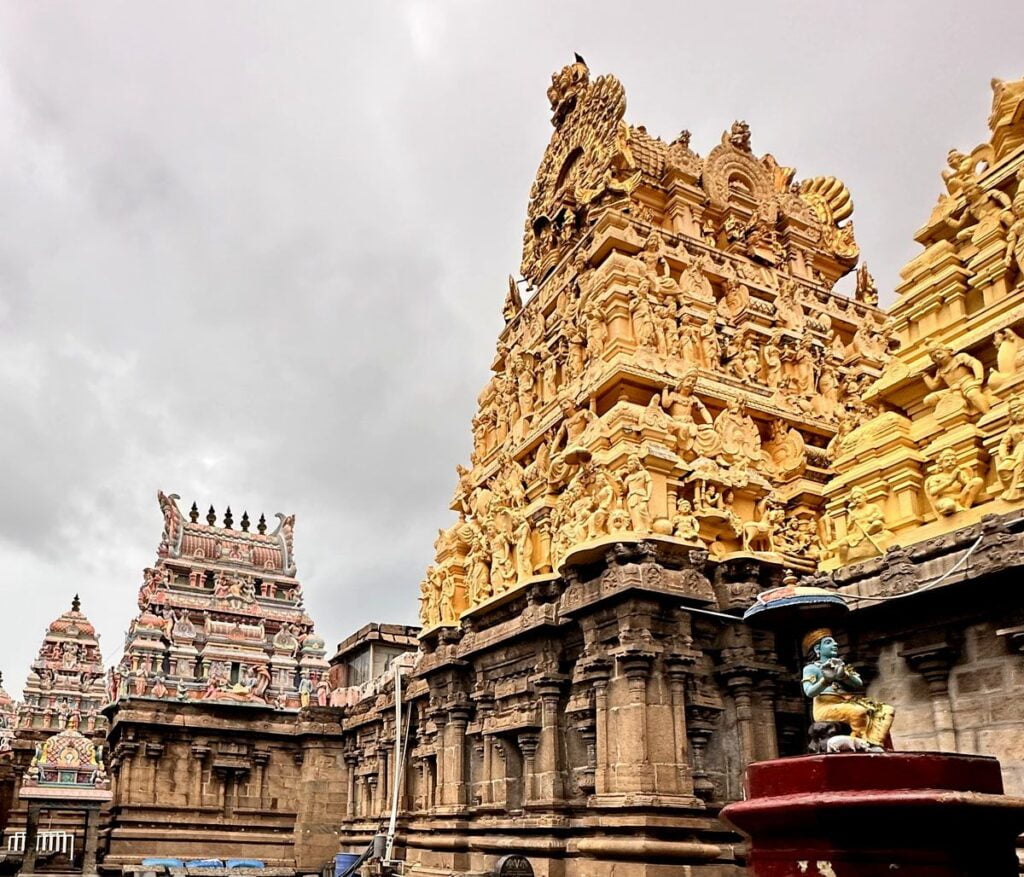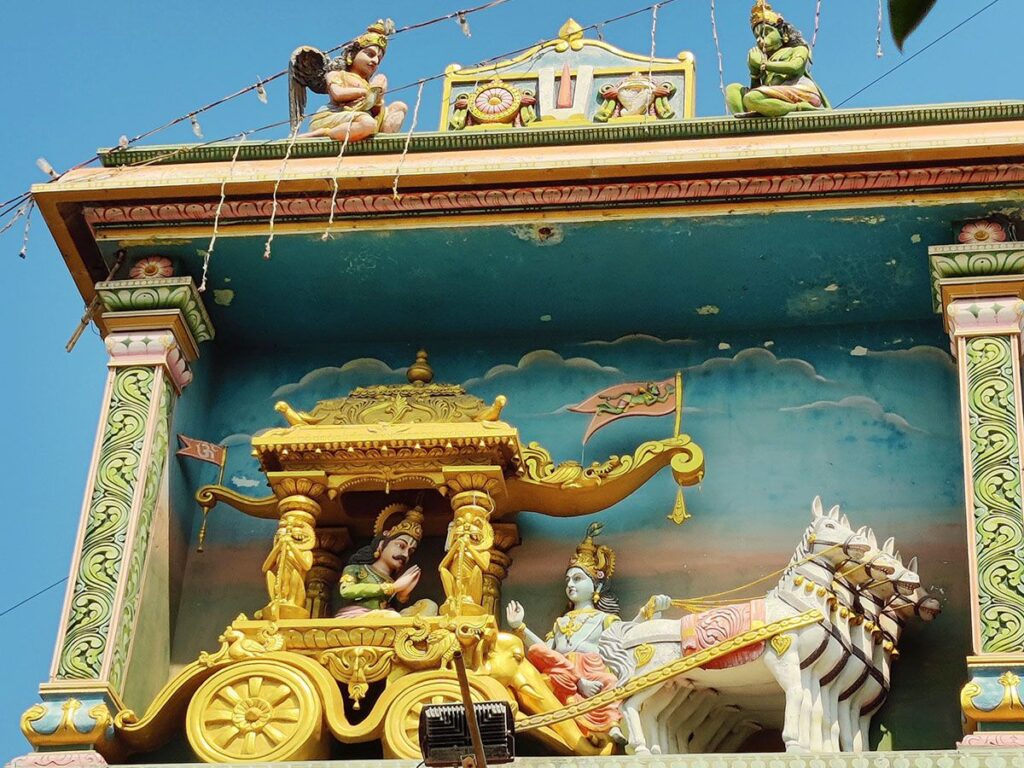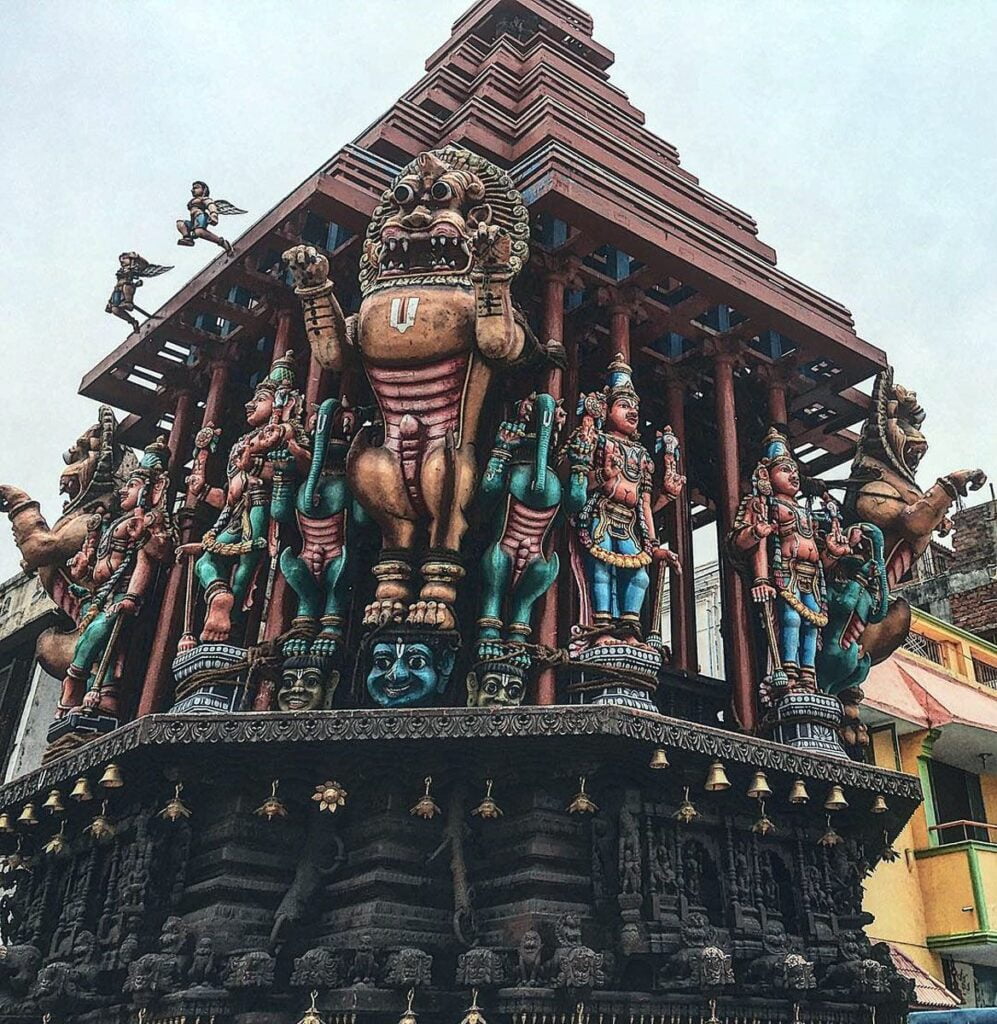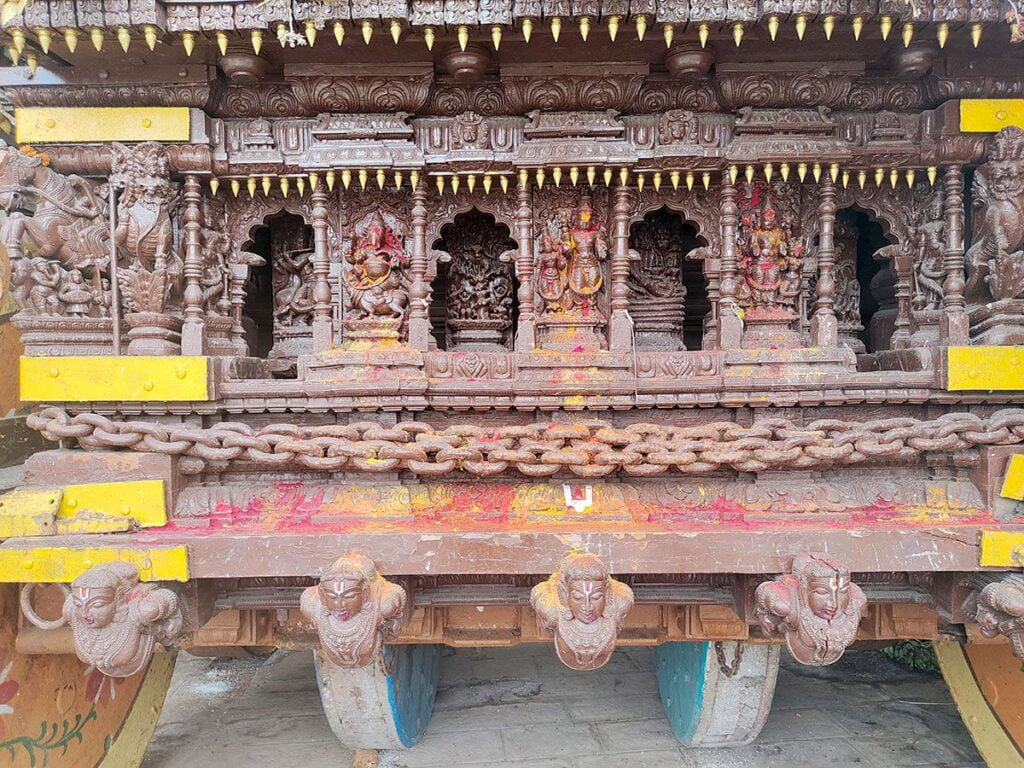Parthasarathy Temple Chennai
The Arulmigu Thiruvallikeni Parthasarathy Temple is a 6th-century Hindu Vaishnavite temple dedicated to Lord Vishnu, particularly in his form as Krishna, the charioteer of Arjuna in the epic Mahabharata. This temple is one of the 108 Divya Desams, which are sacred shrines dedicated to Lord Vishnu.

Contents
- 1 History of Parthasarathy Temple:
- 2 Legend of Parthasarathy Temple:
- 3 Myths of Parthasarathy Temple:
- 4 Significance of Parthasarathy Temple:
- 5 Architecture of Parthasarathy Temple:
- 6 Parthasarathy Temple Timing and Rituals:
- 7 Places to visit near Parthasarathy Temple:
- 8 FAQ:
- 8.0.1 1. What is the Parthasarathy Temple?
- 8.0.2 2. When was the temple built?
- 8.0.3 3. What is the architectural style of the temple?
- 8.0.4 4. Who is the main deity worshipped in the temple?
- 8.0.5 5. What are some of the important festivals celebrated at the temple?
- 8.0.6 6. What are the timings of the temple?
- 8.0.7 7. How can I reach the temple?
- 8.0.8 8. Is there an entry fee for the temple?
- 8.0.9 9. What are some of the interesting facts about the temple?
- 9 How to reach Parthasarathy Temple:
- 10 Google Maps:
History of Parthasarathy Temple:
Early Beginnings (6th-8th Century):
- The temple’s construction is attributed to the mighty Pallavas, specifically King Narasimhavarman I who ruled between 630-668 CE.
- Dedicated to Lord Vishnu in his aspect as Parthasarathy, meaning “charioteer of Arjuna” (referring to his role in the Mahabharata), the temple was originally a modest structure. Inscriptions dating back to the 8th century, possibly from the reign of King Dantivarman, hint at early expansions and renovations. Saint Thirumangai Alvar, an 8th-century poet-saint, glorified the temple in his verses, solidifying its importance in Vaishnava tradition.
Medieval Transformations (9th-15th Century):
- The Cholas, who succeeded the Pallavas, played a significant role in shaping the temple’s landscape.
- They enlarged the complex, adding several shrines and mandapas (halls). The Vijayanagara kings, known for their patronage of the arts and religion, further embellished the temple in the 15th century. Exquisite carvings, intricate gopurams (gateway towers), and vibrant murals were added during this period, reflecting the architectural prowess of the era.
Enduring Legacy (16th Century onwards):
- Despite facing challenges during Portuguese and British rule, the temple’s significance never diminished.
- It has undergone continuous restoration and maintenance efforts, ensuring its preservation for future generations.
- Today, the Parthasarathy Temple remains a vibrant center of faith, attracting devotees from all over India and beyond.
- Its rich history whispers through its ancient walls, echoing the chants of saints and the footsteps of kings, making it a true treasure of Chennai’s cultural heritage.
Beyond Chennai:
While the Parthasarathy Temple in Chennai is undoubtedly the most renowned, there are other temples bearing the same name across India, each with its own unique story:
- Aranmula Parthasarathy Temple in Kerala: Legend attributes its construction to Arjuna, seeking atonement for killing Karna in the Mahabharata.
- Parthasarathy Temple, Parthivapuram in Tamil Nadu: Built by the Ay king Karunandadakkan in the 9th century, it boasts extensive historical records and a charming ambiance.
Read More>> Murudeshwar Temple Karnataka: India’s 2nd Massive Shiva Statue

Legend of Parthasarathy Temple:
The Parthasarathy Temple in Chennai boasts not one, but a tapestry of fascinating legends intertwined with its history and mythology. Here are a few noteworthy ones:
1. Arjuna’s Chariot and the Name: The temple’s name itself, “Parthasarathy,” translates to “charioteer of Arjuna.” Legend has it that Lord Krishna, an avatar of Vishnu, took the form of charioteer and guided Arjuna, the Pandava prince, through the epic battle of Kurukshetra in the Mahabharata. The temple dedicated to this aspect of Krishna stands as a reminder of his divine guidance and support.
2. The Speaking Saligrama Idol: The sanctum sanctorum houses a unique Saligrama idol of Lord Vishnu, believed to be self-manifested (swayambhura). According to legend, King Narasimhavarman I, the Pallava King who built the temple, heard the idol speak, declaring its own location. This miraculous event fueled the temple’s construction and solidified its significance.
3. The Pallava King and the Peacock Feather: Another legend tells of how Narasimhavarman I faced a dilemma while choosing the temple’s site. To settle the issue, he shot an arrow with a peacock feather attached. The feather miraculously landed on the exact spot where the sanctum sanctorum now stands, confirming its divine selection.
4. The British Mispronunciation and Triplicane: The original Tamil name of the temple was Thiruvallikeni. Legend has it that the British, unable to pronounce it, shortened it to “Triplicane,” the neighborhood where the temple resides. While historically inaccurate, this story adds a unique twist to the temple’s local identity.
5. The Goddess and the Serpent Hole: Within the temple complex lies a sacred tank with a natural spring known as the “Naga Kinar” (serpent well). Legend relates that Goddess Vedavalli Thayar, consort of Lord Parthasarathy, once resided in this well. Devotees offer prayers and seek blessings here, believing it holds immense spiritual power.
Read More>> Komuravelli Mallanna Temple

Myths of Parthasarathy Temple:
Myth of Sage Atreya: Legend has it that the temple was originally built by the sage Atreya, a disciple of Narada. He is said to have worshipped a Vishnu idol made of wood here. This wooden idol is believed to be a part of the deity’s murti (sacred statue) currently housed in the temple.
Myth of the Chola King Sumati: Another legend revolves around a Chola king named Sumati. He dreamt of witnessing Vishnu in his manifestation as Parthasarathy (charioteer of Arjuna). Guided by divine intervention, he reached this holy spot and discovered the Atreya-built temple. He then renovated and expanded the temple, adding the gopurams (tower gates) and mandapams (halls) we see today.
Myth of Srinivasa and Tulasi forest: Some believe that the location of the temple was once a dense forest of tulasi (holy basil) plants. According to this myth, King Sumati wished to visit Tirupati to worship Srinivasa (another form of Vishnu). However, Srinivasa appeared to him in a dream and directed him to the Parthasarathy temple in Chennai, stating that it was already consecrated by sages and housed a sacred Vishnu idol.
Myth of Draupadi: Another interesting legend connects the temple to the epic Mahabharata. It is said that Draupadi, the wife of the Pandavas, worshipped a Parthasarathy idol here during her exile. This idol is believed to be the smaller figure of Parthasarathy seen beside the main murti in the sanctum sanctorum.
Myth of the Five Pandavas: Each of the five Pandavas is also associated with different parts of the temple. For example, the eastern gopuram is attributed to Yudhisthira, the southern gopuram to Bhima, the western gopuram to Arjuna, the northern gopuram to Nakula, and the central shrine to Draupadi.
Read More>> Treta Yuga Vaikom Mahadeva Temple

Significance of Parthasarathy Temple:
Historical Significance:
- Ancient origins: Believed to be over 1500 years old, the temple dates back to the 8th century Pallava dynasty. This makes it one of the oldest temples in Chennai, offering a glimpse into the city’s rich and ancient past.
- Pallava architecture: The temple showcases exquisite Pallava architecture, characterized by intricate carvings, sculptures, and a distinctive pyramidal structure. This architectural style is a testament to the artistic prowess of the Pallava era.
Religious Significance:
- Unique dedication: Unlike most Krishna temples, the Parthasarathy Temple is dedicated to Krishna as Parthasarathy, meaning the charioteer of Arjuna. This specific portrayal is relatively uncommon, making the temple a significant site for devotees of Krishna in this form.
- Trinity of Vishnu avatars: The temple houses idols of three avatars of Vishnu: Narasimha, Rama, and Krishna. This unique feature makes it a rare shrine where devotees can worship all three forms of the deity in one place.
Cultural Significance:
- Festivals and traditions: The temple hosts several vibrant festivals throughout the year, including the Brahmotsavam, Krishna Janmashtami, and Rama Navami. These celebrations attract devotees from all over the city and region, creating a lively and joyous atmosphere.
- Classical arts: The temple has been a patron of classical arts like Carnatic music and Bharatanatyam for centuries. Many renowned artists have performed here, contributing to the temple’s cultural significance and enriching the lives of devotees.
Read More>> 7th Century Virupaksha Temple Hampi

Architecture of Parthasarathy Temple:
A Fusion of Dynasties:
- Pallava Origins: Built originally between the 6th and 8th centuries by the Pallava kings, the temple’s core structure embodies the elegance of Pallava architecture. Imagine intricate brickwork, graceful pillars, and delicate stucco sculptures adorning the early sections.
- Chola Enhancements: The Cholas, renowned for their grand temple constructions, made significant additions in the 10th and 11th centuries. Look for elements like towering gopurams (gateway towers) and intricately carved mandapas (pillared halls) showcasing Chola artistry.
- Vijayanagara Flourish: In the 15th and 16th centuries, the Vijayanagara kings further embellished the temple. They added several sub-shrines, expanded mandapas like the Tiruvaymoli Mandapa, and adorned the gopurams with vibrant stucco figures.
Key Architectural Elements:
- Raja Gopuram: The towering eastern gopuram, a hallmark of Dravidian temple architecture, is a sight to behold. Its nine tiers are adorned with hundreds of intricately sculpted figures depicting deities, mythical creatures, and scenes from Hindu epics.
- Mandapas: The temple complex features several mandapas, each serving a specific purpose. The thousand-pillared mandapa, built in the 16th century, is a marvel of architectural ingenuity.
- Sculptures: The temple walls and mandapas are adorned with exquisite sculptures depicting various deities, mythological scenes, and everyday life. These intricate carvings offer a glimpse into the artistic prowess of ancient India.
- Sanctum Sanctorum: The heart of the temple is the sanctum sanctorum, housing the nine-foot-tall standing image of Lord Krishna as Parthasarathy, meaning “charioteer of Arjuna.”
Beyond the Architecture:
The Parthasarathy Temple’s architectural beauty is just one facet of its significance. It’s a vibrant center of spiritual life, hosting daily pujas (prayer rituals) and bustling with devotees throughout the year. The temple also holds special significance during festivals like Krishna Janmashtami and Brahmotsavam, when the entire complex comes alive with colorful decorations and joyous celebrations.
Parthasarathy Temple Timing and Rituals:
Timings:
- General Darshan: 6:00 AM to 8:00 PM
- Seva Pujas: Various pujas are performed throughout the day, with specific timings for each. Some notable ones include:
- Suprabhatham and Thiruvanandal: 6:00 AM
- Thirumanjanam: 9:00 AM and 5:00 PM
- Sayarakshai Puja: 6:00 PM
- Ekantha Seva: 8:00 PM
- Friday evenings: During the evenings on Fridays, special pujas and processions are held for Goddess Vedavalli Thayar, consort of Lord Parthasarathy.
Rituals:
- Darshan: Darshan refers to seeing the deity. Devotees can view the main deity, Lord Parthasarathy, and other deities in the temple during general darshan timings. Darshan queues may form, especially during weekends and festivals.
- Archanas: Archana is a special puja offered to the deity by a priest on behalf of the devotee. Devotees can choose specific archanas based on their desires or needs.
- Offerings: Offerings of flowers, fruit, and prasadam (blessed food) are common practices at the temple. You can purchase these offerings from shops outside the temple or bring your own.
- Festivals: The temple celebrates various festivals throughout the year, including Panguni Uthiram, Pallava Utsavam, Ramanujar Utsavam, and Vaikunda Ekadashi. Each festival has its own unique rituals and traditions.
Places to visit near Parthasarathy Temple:
- Marina Beach: One of the most famous beaches in Chennai, Marina Beach is a short distance away from Parthasarathy Temple. You can enjoy a leisurely stroll along the shoreline, try local street food, and experience the vibrant atmosphere.
- Kapaleeshwarar Temple: Another prominent temple in Chennai, Kapaleeshwarar Temple is dedicated to Lord Shiva and is known for its impressive Dravidian architecture. It’s located in Mylapore, not far from Parthasarathy Temple.
- Santhome Basilica: This historic church is built over the tomb of St. Thomas, one of the twelve apostles of Jesus Christ. It’s an important pilgrimage site and showcases colonial architecture. Santhome Basilica is also situated in Mylapore.
- Vivekananda House (Ice House): Located on Marina Beach, this is the place where Swami Vivekananda stayed for a brief period. The house now serves as a museum displaying his life and teachings.
- Fort St. George: This is the first English fortress in India, built in 1644. It houses the Tamil Nadu Legislative Assembly and other official buildings. The Fort Museum within the complex exhibits artifacts from the British colonial era.
- Government Museum: Located in Egmore, this museum is one of the oldest in India and has a diverse collection of art, archaeology, and natural history exhibits.
- Parthasarathy Swamy Sabha: If you are interested in classical music and dance, check out the events at Parthasarathy Swamy Sabha. It is a cultural organization that hosts performances and events.
- Semmozhi Poonga: A botanical garden situated in the heart of Chennai, it’s a great place for nature lovers. The garden features a variety of plants, trees, and a beautiful landscape.
- Chetpet Ecopark: This park offers a serene environment with a lake and walking trails. It’s a good place to unwind and enjoy some greenery within the city.
- Birla Planetarium: Located near the Anna Flyover, the Birla Planetarium is a popular attraction for those interested in astronomy. It hosts shows on various astronomical topics.
FAQ:
1. What is the Parthasarathy Temple?
The Parthasarathy Temple is a 6th-century Hindu Vaishnavite temple dedicated to Lord Vishnu, located in the neighbourhood of Thiruvallikeni, Chennai, India. It is one of the 108 Divyadesams, considered sacred shrines for Vaishnavites. The name “Parthasarathy” means “charioteer of Arjuna,” referring to Lord Krishna’s role in the epic Mahabharata.
2. When was the temple built?
The temple was originally built by the Pallavas in the 6th century CE, during the reign of King Narasimhavarman I. It was later expanded by the Cholas and Vijayanagara kings in the following centuries.
3. What is the architectural style of the temple?
The Parthasarathy Temple is a classic example of Dravidian architecture, characterized by its gopurams (tower gateways), mandapams (halls), and intricately carved sculptures. The main gopuram is 58 feet tall and adorned with colorful stucco figures.
4. Who is the main deity worshipped in the temple?
The main deity worshipped in the Parthasarathy Temple is Lord Vishnu, in his form as Parthasarathy. He is depicted standing on a chariot, with his consorts Sridevi and Bhudevi on either side.
5. What are some of the important festivals celebrated at the temple?
Several festivals are celebrated at the Parthasarathy Temple throughout the year, including:
- Panguni Uthiram: This festival marks the birth of Lord Vishnu and is celebrated in March-April with grand processions and rituals.
- Brahmotsavam: This 10-day festival in August-September is the most important festival of the temple, featuring special pujas, music performances, and chariot processions.
- Vaikunta Ekadasi: This festival in December-January celebrates the opening of the gates of heaven, and devotees believe that worshipping Vishnu on this day will grant them liberation.
6. What are the timings of the temple?
The Parthasarathy Temple is open from 6:00 AM to 8:00 PM every day. Special darshan timings for the main deity are available in the mornings and evenings.
7. How can I reach the temple?
The Parthasarathy Temple is located in Triplicane, Chennai, and is easily accessible by public transportation. The nearest bus stop is Triplicane High Road, and the nearest metro station is Thiruvallikeni.
8. Is there an entry fee for the temple?
There is no entry fee for the Parthasarathy Temple. However, devotees can make offerings to the deity as per their wishes.
9. What are some of the interesting facts about the temple?
- The Parthasarathy Temple is the oldest surviving structure in Chennai.
- The temple is mentioned in the Naalayira Divya Prabandham, a collection of Tamil hymns dedicated to Vishnu.
- Several famous personalities, including Swami Vivekananda and Bharathiyar, have been devotees of the temple.
How to reach Parthasarathy Temple:
By Air: The nearest airport is Chennai International Airport (MAA). From the airport, you can hire a taxi or use other transportation options to reach Triplicane, where the temple is situated.
By Train: Chennai has multiple railway stations. The closest one to Parthasarathy Temple is Chennai Central Railway Station. From the station, you can take a taxi, auto-rickshaw, or use public transportation to reach Triplicane.
By Bus: Chennai has an extensive bus network. You can find buses that pass through or near Triplicane. The temple is a well-known landmark, so you can ask for directions once you reach the vicinity.
By Car: If you are driving, you can use GPS navigation services to reach Parthasarathy Temple. The temple is a prominent landmark in Triplicane, and local signboards should guide you.
Local Transportation: Once you reach Triplicane, you can use local transportation options such as auto-rickshaws, cycle rickshaws, or taxis to reach Parthasarathy Temple. It’s a well-known place, and locals can guide you.
For more details visit the temple’s official website https://parthasarathy.hrce.tn.gov.in/

One Comment